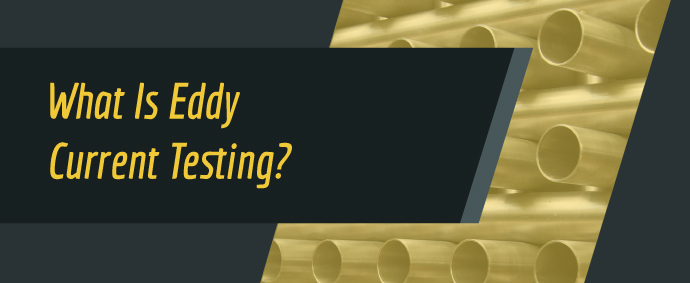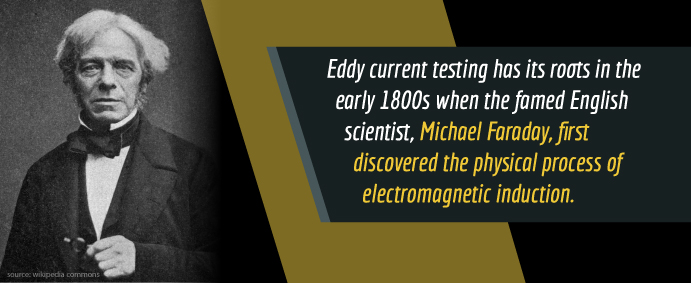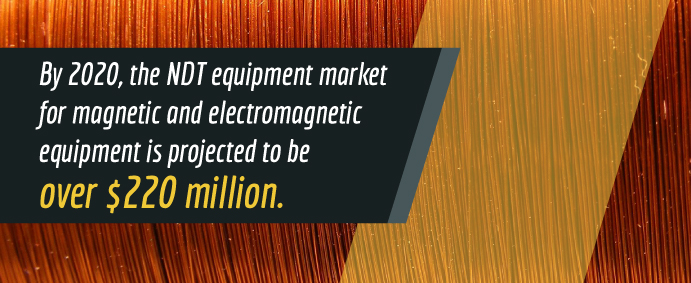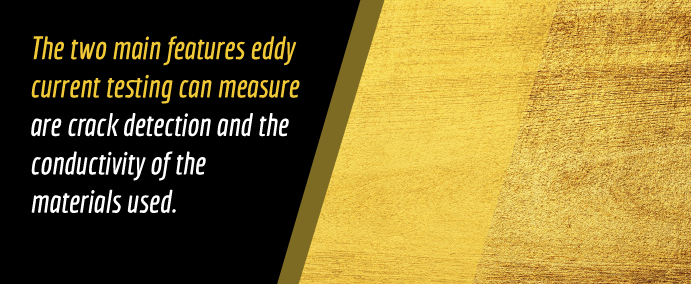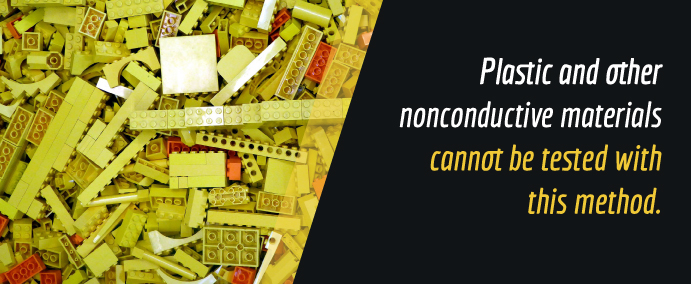Eddy current testing is a method of non-destructive testing, or NDT, that utilizes the process of electromagnetic induction for the evaluation and measurement of conductive materials without causing damage. Eddy current testing, or ECT, is used primarily in the detection of surface and sub-surface flaws such as cracks in conductive materials like metal, and it is often used for applications in both aerospace and manufacturing.
In addition, eddy current testing can be useful in determining needed measurements and identifying corrosion resistance, as well as determining conductivity, metal hardness and some thermal properties of the material.
Unlike other methods of non-destructive testing, eddy current testing does not require the use of liquids, and it is an excellent method of checking a metal’s surface structure and finding flaws. Its use is only effective on a limited range of materials that conduct electricity. While eddy-current testing is a proven method for conductive materials, other materials such as the surfaces of plastics cannot be tested with this method. To complement what the process offers, in some cases eddy current testing will be conducted in correspondence with ultrasonic testing methods, with ECT providing the surface testing and ultrasonic methods penetrating the material for increased depth.
Throughout this brief guide to eddy current testing,we will examine its history, how it works, its function and the many advantages the process offers. We will look at its common applications and some of its limitation in industrial use.
The History of Eddy Current Testing
Eddy current testing has its roots in the early 1800s when the famed English scientist, Michael Faraday, first discovered the physical process of electromagnetic induction. In 1831, Faraday discovered that when a closed path in which an electric current can circulate is used in tandem with a time-varying magnetic field passing through a conductor, an electric current will flow through it.
Electromagnetic induction, or magnetic induction, is a powerful force, and it is the principle that drives our electric motors and generators. Electromagnetic induction has a wide range of technological applications throughout history. This is the same method used for our induction cooking tools, induction welding, charging and sealing methods as well.
Eddy current testing utilizes this physical process. Conductors moving through a uniform magnetic field, or time-varying field, will induce currents. Eddy currents flow in closed loops within conductors, and they were first discovered shortly after Faraday’s early work. However, in most applications, these are often undesirable eddy currents as they can dissipate energy in the resistance of the conductor. To mitigate the impacts of these undesirable eddy currents, inductive coils in electronics are often used to minimize flow.
While the effects of eddy currents were first observed nearly a decade before Faraday’s discovery, French physicist Leon Foucault garners the credit for the discovery in 1855. While many developments continued following these discoveries, the development of eddy current testing for industry was not implemented until during the Second World War in Germany.
Friedrich Forster, the one who had adapted eddy current technology during the war, went on to found the Forster Group, which made advancements in developing ECT technologies. Today, eddy current testing is widely used and is an incredibly useful method of detective flaws in the surfaces of conductive materials. ECT is also indispensable when conducting thickness and conductivity measurements.
Today, eddy current testing companies are in high demand. By 2020, the NDT equipment market for magnetic and electromagnetic equipment is projected to be over $220 million.
How Eddy Current Testing Works
Relying on the process of electromagnetic induction, an alternating current flows through a wire coil and produces a fluctuating magnetic field in an eddy current probe. The testing procedure uses an ECT probe, which is a coil of conductive wire that is excited by the alternating electric current. This causes the wire coil to produce an alternating magnetic field. As the field oscillates at the same frequency of the current running through the coil, currents opposite of the these, or eddy currents, are induced into the conductive testing material.
These variations in electrical conductivity are used to test the object by detecting the presents of defects. If the eddy currents prompt a change in both phase and amplitude, it means a defect is present. This process is measured in the coil and can indicate the sign of surface and subsurface flaws of the conductive material.
The way the electrons behave when the probe is placed closely to the testing material is similar to water in a stream. As the eddy currents and their magnetic field flow through the metal testing material, they will continually interact with the coil and its magnetic field through induction. Changes in the thickness of the metal or surface cracks, for example, will interrupt this pattern and the field.
These shifts are detectable by a trained operator, who can then determine the quality of the testing material. At the surface of the material, the currents are at their highest density. This provides the best resolution for surface testing. Variations in the material’s conductivity can impact the frequency of the alternating current, resolution and depth the eddy currents can penetrate.
The higher the conductivity of the material used, the better inspection and analysis can be obtained through the ECT processes. For large volumes of material, larger coils can be used and will help increase the depth. Conductivity and other properties of the testing material are not able to be controlled by the operator, but a skilled professional can determine the coil type needed, the size and other testing requirements to provide the best ECT results.
In some cases, multiple frequencies can be used to help provide better results. Other times, the use of multiple probes can help achieve a better resolution and penetration to detect flaws. Skilled operators looking to provide the best testing performances can select the right type of probe and determine the demand for additional frequencies and probes.
Unfortunately, because it relies on electricity, eddy current testing can’t be conducted on other types of non-conductive materials like ceramics or plastics. There are also limitations to the depth eddy currents can reach, making ultrasonic non-destructive testing methods much more useful for depth penetration. When used together with ultrasonic methods, eddy current testing can be optimized for superior accuracy and resolution.
Why Is Eddy Current Testing Used?
The primary use for eddy current testing is to determine if a material has surface or subsurface flaws. ECT provides a major advantage as it can be used to test large volumes of material rather quickly. The two main features eddy current testing can measure are crack detection and the conductivity of the materials used. Cracks can cause disruption in the flow patterns of the eddy currents and weaken them. Conductivity can be detected because the ECT instruments used are sensitive to any changes in the materials properties.
Small surface cracks and defects near the material can indicate the material is not fit for use in the application. Skilled operators are needed to understand the instruments of the ECT testing process and detect issues with materials. In some cases, a surface finish or the roughness of the material can impact testing.
In addition, it is common that eddy current testing is used in determining metal thickness, detecting thinning caused by corrosion or determining coating thickness or magnetic permeability. Operators must have an intricate knowledge of how to select the proper probe, which fits the geometry of the part and coil to produce the proper current flow. They must also understand the type of defect they are detecting, where it is located and its position.
A skilled operator must be able to work within frequencies to achieve the most optimal resolution for testing. With the highest density of eddy currents at the surface, sub-surface flaws demand lower frequencies to penetrate deeper into the material, but this will result in less sensitivity. Also, ferromagnetic or other highly conductive materials will demand the use of lower frequencies as well.
Different Types of Eddy Current Testing Probes and Calibration
Trainer operators know selecting the right probe that fits the geometry of the coil and size of the material is essential to conducting a proper examination. Eddy current testing instruments must also always be calibrated to the proper standards for each test. It is imperative for the operator to identify the test piece and how it behaves under changing conditions.
Calibration involves using reference guidelines like material, shape, size and any preexisting defects such as cuts, holes and milled features. In addition, thickness measurements rely on samples of known thickness. By taking into account preexisting features on the test piece, an operator can determine what is essential when setting up the probe for the testing process.
There are also a variety of different probes that can be used, all of which offer advantages in optimizing the overall performance and results of the testing. Some of the most common probes used are surface probes which can identify flaws on a material’s surface or sub-surface. They are also usually larger in diameter and depend on lower frequencies for increased depth penetration. Surface probes are excellent for testing large surface areas.
For those applications that require higher frequencies or even higher resolution of near surface flaws, a pencil probe may be used as it offers small diameter coil. For machined parts or materials, sometimes a bolt hole probe is used to inspect the holes in a material. This can be operated by hand, or by machine, allowing for maximum flexibility.
For other types of fastener holes, a donut probe may be used for inspection. Sliding probes which operate at higher scan rates for fastener holes can also be used. In applications with tubing, ID probes can be used for inspection and come in a large range of sizes. In addition, OD probes where the test piece is moved through the coil can be used for the exterior testing of tubes and bars.
Common Applications for Eddy Current Testing
Eddy current testing is used is such a wide variety of applications for industries that demand materials to be defect free, but some of the most common applications for ECT are in high demand for welded components or materials that need to be corrosion resistant.
Corrosion can be detected by eddy current testing and if the metal has thinned. Low frequencies are often employed to locate corrosion on the subsurface of the metal layers, which are unable to be detected by other methods such as ultrasonic testing.
Welding inspections are commonly conducted with both eddy current testing and other non-destructive testing methods like ultrasonic inspection. This is often used to test the subsurface and scan for surface cracks or caps in the areas that were impacted by heat. As mentioned, conductivity testing is also common for both iron based and nonferrous alloys.
In manufacturing, or CNC machining, critical components often rely heavily on eddy current testing to inspect for surface cracks following the process. In the aerospace industry, areas around fasteners or critical points also relies on eddy current testing to indicate if there are any flaws in the material. As mentioned, bolt hole inspection using specific probes is very common, and they can either be done by hand or with a rotary scanning system.
The Advantages and Limitations of Eddy Current Testing
Throughout this brief guide, we have looked at the main uses and effective ways eddy current testing is used. Eddy current testing is extremely advantageous for inspecting conductive materials for flaws, cracks or defects that could be detrimental for critical applications. The process relies on the use of electromagnetic induction, and it requires the use of a conductive material to conduct the testing.
Plastics and other non conductive materials cannot be tested with this method. In addition, because the density of the eddy current is at its highest at the surface of the material, deep penetration for thicker materials is not always achievable. It is common, that other methods such as ultrasonic detection will be used in unison with eddy current testing because it provides a great depth.
However, despite these limitations, eddy current testing is a tried and proven method for its sensitivity in detecting any small tiny cracks and other defects that are not clearly visible. In addition, the coil probes used are highly portable and flexible. Eddy current testing also offers other advantages outside of flaw detection. It can be used for measuring corrosion, metal hardness and thickness of materials. It is also useful for a wide range of complex shapes and sizes of materials, allowing operators to quickly inspect large volumes and large surface areas.


